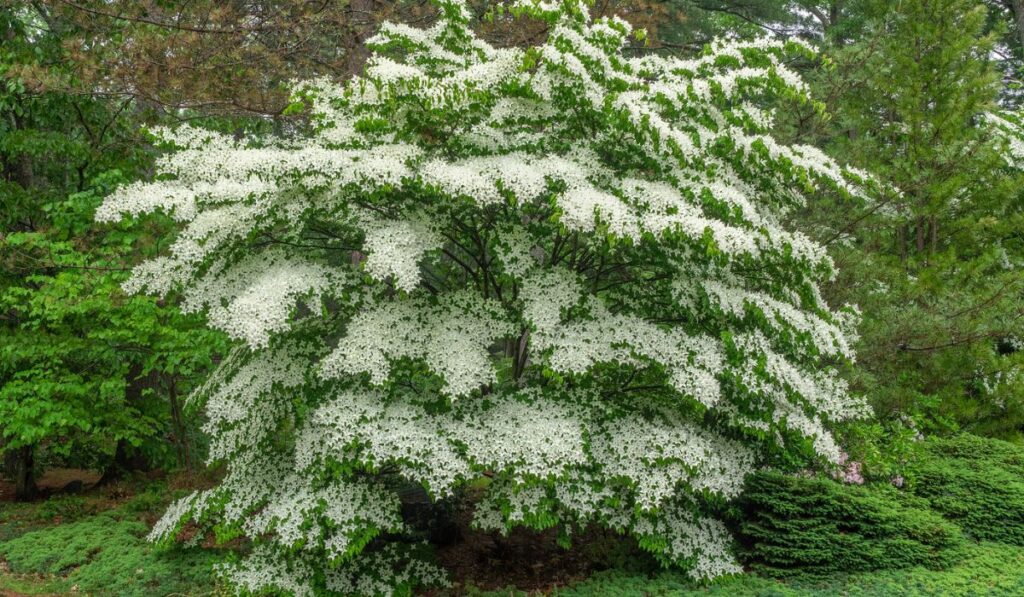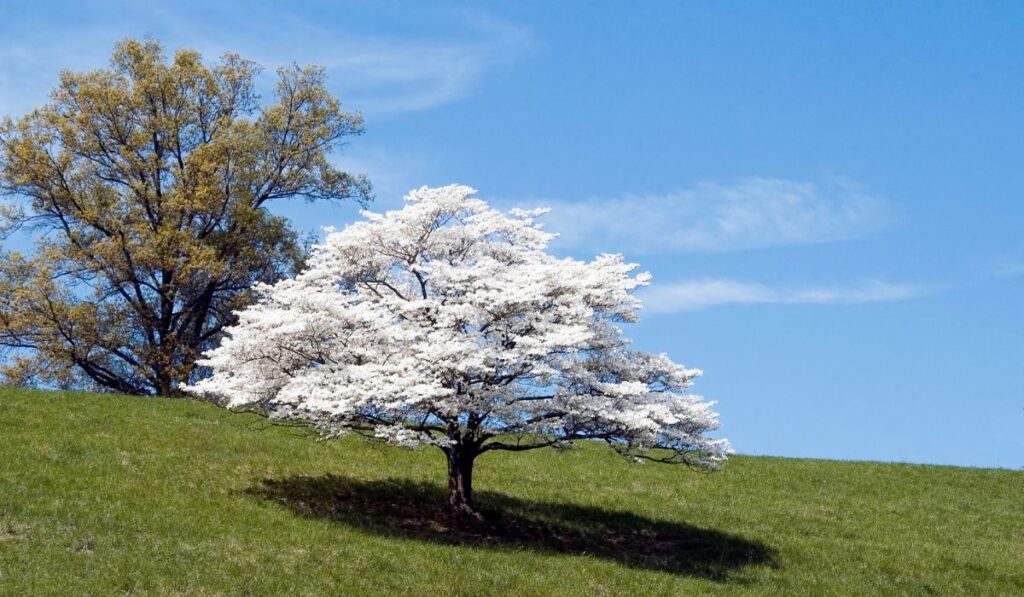Want to know when and how to plant a dogwood tree? The dogwood tree is a beautiful addition to your garden if you want a bright tree with a long lifespan and a lot of shade. However, you must plant them at the right time at the right location for proper blossom.
Plant dogwood trees in late autumn or early spring in soil full of moisture and nutrients yet having sufficient drainage. Let the trees grow and blossom before the dormant winter season and the full sunlight of summer. Add 2-3 inches of mulch layer for proper growth of the dogwood tree.
Dogwood trees require specific soil and watering conditions. Choosing the right fertilizer and keeping the tree away from pests and diseases is vital for its health. So, let’s find out everything about planting dogwood trees!
When to Plant a Dogwood Tree?

Dogwood trees bloom with beautiful shades providing a glorious view in your garden year-round. They turn red to purple in autumn, taking on a different and beautiful shade than their spring shade. In the spring, the light green leaves of dogwood provide ample shade.
But what is the best time to plant a dogwood tree?
Dogwood trees require nutrient-rich, moist soil with well-drainage. The best time to plant them is in spring. As dogwoods are deciduous, they won’t bloom in winter during dry and freezing weather.
If you are planting a mature dogwood tree, you can also plant it in late fall. However, the best time for a young, fresh dogwood tree is early spring. The tree should have enough time to grow and blossom into its beautiful form before winter starts.
Planting a dogwood tree in the summer isn’t a good idea. In the summer, the sunlight is at its highest, causing sun damage to the trees. Too much sunlight for a young tree will do more harm than good. So, choose a time between spring or fall according to the condition of your dogwood tree.
Dogwood Tree Varieties
The most interesting part about dogwood trees is their variety. There are many dogwood tree varieties, but here we will discuss the most common ones. The dogwood varieties mentioned below are easy to maintain and grow in most regions. So, let’s get started!
Flowering Dogwood
Flowering dogwood is the most famous variety. Usually, the gardeners are familiar with this variety. It is native to Eastern US. It grows into white or pink flowers in either winter or late spring. The flowers turn into berries in summer, attracting different songbird species.
Flowering dogwoods grow shorter in full sun. So, if you want a full canopy shade, plant them in the shade but remember that the fall color in the shade will be poor. They grow up to 20 feet with a 6-12 meter trunk.
Kousa Dogwood
Kousa dogwood flowers later than flowering dogwood. However, the leaves come earlier than flowers in this variety. The flowers turn to raspberries-like fruits with a mealy texture. They are edible for humans and white, turning purplish-red in fall.
For a cooler temperature, such as in zone 4 through 8, it is a suitable variety. It can grow 20-30 feet tall with a 20-25 foot spread at maturity.
Cornelian Cherry Dogwood
Cornelian Cherry dogwood grows to the height of 20 feet. In areas with hot summers, the tree might look tattered by the end of the season. However, it grows perfectly in zone 5 through 8.
The dark-red cherry-like fruits of Cornelian Cherry dogwood are ripe in July after the medium-foliage comes in summer. The yellow flowers of Cornelian Cherry cover the whole tree before the leaves arrive.
Pacific Dogwood
Pacific dogwood doesn’t thrive in the East. But it is the variety of dogwood growing the tallest among all. It lives up to 150 years and can grow to a height of 66 feet.
It has bright red fruits and light green foliage. The flowers appear greenish-white with a purple tinge.
How to Plant a Dogwood Tree?
You can plant a dogwood tree in simple steps. You can use both bare roots or potted bare roots for planting a dogwood tree. The soil in which you plant a dogwood tree should be rich in nutrients.
Adding a mixture of 50% compost to the soil will make it bloom perfectly. You can use the All Season Bokashi Compost Mixture (on Amazon).
To plant a dogwood tree, follow the steps below!
- Dogwood tree requires a hole that is ⅔ of its root ball length. It has to be slightly above the soil, about ¼ of its length. Place the root ball in the soil after gently teasing the roots.
- Once placed, put back soil in the hole. Make sure there are no air pockets.
- Water the soil thoroughly when the tree sets in.
- Add a mulch layer to retain the water. The munch layer should be at least 2-3 inches from the tree’s trunk.
Things to Consider Before Planting
Here are some things to consider before planting a dogwood tree:
- Choose a location with partial shade.
- Don’t plant the dogwood trees near plants requiring full sun, as dogwood trees cast ample shade of their own.
- The soil should be rich in nutrients with good drainage and moisture.
- Acidic to neutral soil is best for dogwood trees.
- You can’t regularly rearrange your garden containing a dogwood tree. It is because dogwood trees have a long lifespan. This tree is a lifetime commitment.
Maintaining Dogwood Trees

Dogwood trees are not high maintenance but require good watering conditions. The primary requirements of dogwood trees are explained below!
Sunlight
Dogwood trees thrive best in partially shady areas. In full sun, the trees are short but if you want a full canopy, choose a partially shaded location. Four hours of sun every day is enough for dogwood trees.
Watering
During the first year, dogwood trees require frequent watering. If you live in a dry area, watering the dogwood trees at least twice a week is necessary.
An inch of water every week is required to keep the dogwood trees healthy. Otherwise, the roots will dry out, and the tree might die. Therefore, if rain is insufficient in your area, water your dogwood trees regularly.
Soil
The pH of the soil should be 5.5-7.0 for dogwood trees. They require well-drained soil with enough moisture.
You don’t need expensive soil for dogwood. Traditional garden soil containing peat, sand, vermiculite, moss, and perlite is perfect for dogwood. However, adding mulch to the soil is helpful for the tree for water retention.
Fertilizer
Nitrogen-rich fertilizers are great for dogwood trees. But if your soil has a good mixture of all the 16 essential nutrients, you don’t need fertilizer.
Add fertilizer when the tree is 6 feet tall. ¼ cup is a sufficient aDon’t. Don’t add more fertilizer until three months, after which you can add in the same amount. You can choose a fertilizer like the Espoma Organic Holly-Tone Fertilizer (on Amazon).
Diseases and Pests
Keeping the dogwood tree away from diseases and pests is essential for its long-lasting and healthy lifespan.
One of the most common diseases for dogwood is anthracnose. It is a fungal disease. It starts at the roots and reaches the trunks. Some symptoms include smaller branches, blighted leaves, light-brownish lead edges, and purple leaf margins.
If you live in an area where anthracnose is common, use the Kousa dogwood variety. Pacific and Flowering dogwood varieties are susceptible to this disease.
Pests of dogwood tree include:
- The dogwood borer is among those pests that consider dogwood their home. It results in the branches dying slowly. Keeping the base of your tree well-mulched can prevent the dogwood borer.
- Sawfly larvae attack the dogwood trees. You will need chemical control for this pest if it is in large quantities. However, you can easily remove tiny caterpillars by hand.
- Scale insects are common pests for dogwood trees. To prevent scale crawlers, use insecticides and provide the tree with proper irrigation and nutrients.
- Dogwood club gall midge affects the leaves of the dogwood tree. For managing these pests, pruning is a good treatment option.
Final Thoughts
The dogwood doesn’t require much maintenance once you have planted it. All you need to do is choose a shady location with proper drainage and water the tree once or twice every week.
These trees provide a bright aesthetic year-round in your garden. The foliage is excellent for shade, and the fruits are attractive to many birds.
